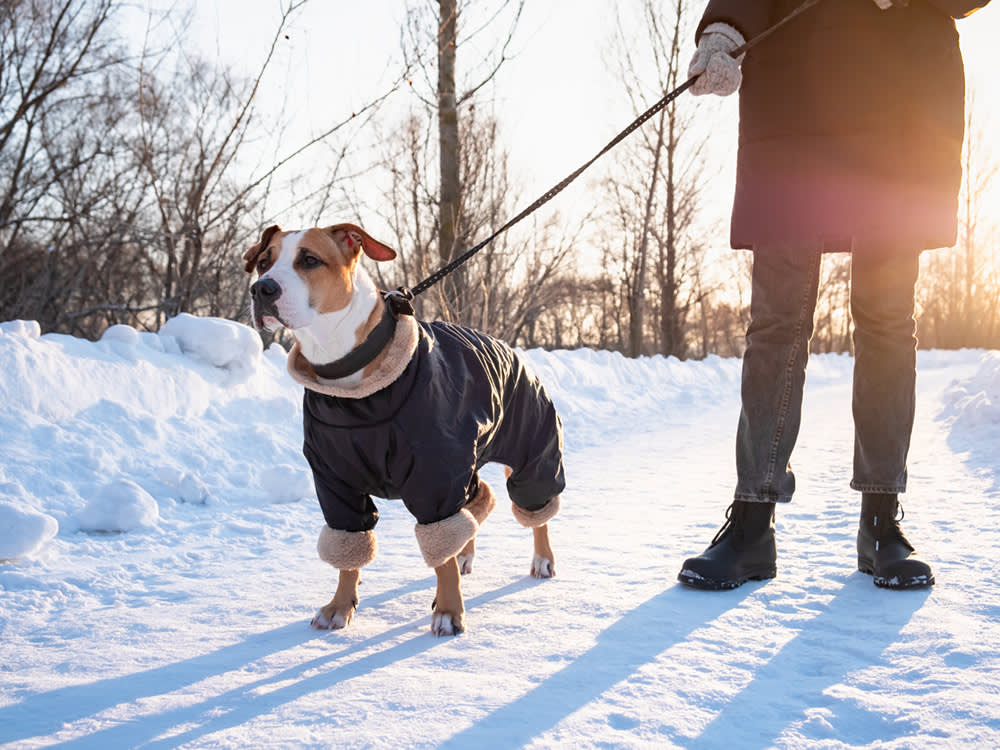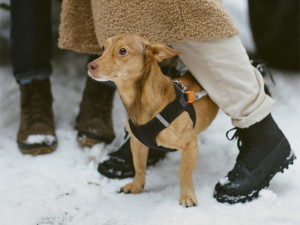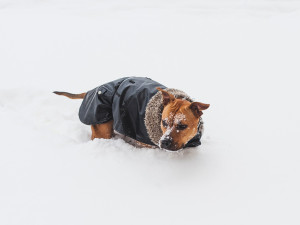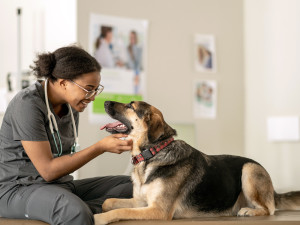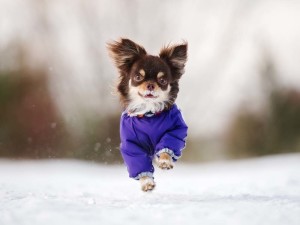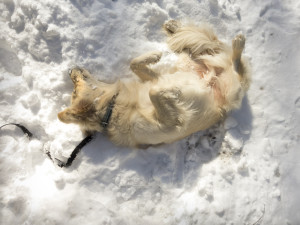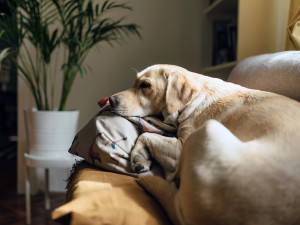How Do I Get My Dog to Wear a Winter Coat?
Chilly pup refusing to layer? Here’s how to train them to love their winter wardrobe
In this article:
Do dogs get cold? Is it safe to put my dog in a winter coat? How to decide if your dog needs a coat Signs your dog needs a winter coat Breeds that should wear a coat Train your dog to wear a coat
OK, so you found your dog the cosiest (and most Instagrammable) winter accessory, but they seem to have different tastes. If your pup runs in the other direction of their new winter coat or goes berserk when you try to pull their fuzzy little legs through the sleeves, you aren’t alone; lots of dogs are resistant to dressing up. But don’t stress: there are ways to train your dog to appreciate their winter wardrobe.
Before you start training though, you should also consider whether or not your pup really needs a winter coat. If they naturally have a long, thick coat – think Husky or Pomeranian – they probably do not need to wear a coat or jacket. But if your dog is slick-coated, very young, elderly or suffering from a medical condition like arthritis, a coat can help keep them comfortable when temperatures drop. Also, in winter, dog coats can help keep your small pup from shivering; it’s harder for little guys to retain body heat.
It’s also a good idea to consider how long you’re going to be outside. Your dog may be fine going coatless on a brief, 10-minute walk to do their business. But if you’re planning to take a hike on a cold winter’s day in the snow, they’ll probably appreciate some extra help staying warm.
Do dogs get cold?
Seriously, though, do dogs need coats? Just like people, dogs can get coldopens in new tab, but just when they get cold depends on things like their coat length and type, as well as size. Some breeds, such as the Alaskan Malamute and Siberian Husky, are bred for cold weather and may even be reluctant to come inside out of the snow, while smaller dogs may start shivering at the first cold snap.
Experiencing intense cold without the proper protection is dangerous for dogs and can lead to hypothermia, which can be fatal in serious cases. Cold weather can also cause frostbite on your dog’s ears, tail, or paws.
Is it safe to put a winter coat on my dog?
A winter jacket is perfectly safe for your pup, as long as you only dress them up at the proper time. Never put a coat on them when the weather is mild or they’re indoors, because this can lead to overheating. And no matter how cute they look, don’t force your dog to wear a coat if they’re ardently opposed. Instead, use positive reinforcement to encourage them over time.
How to decide if your dog needs a jacket
Not every dog needs a winter coat. In many cases, it depends on the dog, as well as the temperature, so it’s up to responsible pet parents to determine if dog winter clothes are necessary. It’s always a good idea to monitor pups when they’re outside in cold weather, so you can notice any signs that they’re struggling with the dropping temperatures.
If your dog is especially active, even in winter, dog coats may just not be necessary. You don’t want them to have the opposite problem and get overheated. But at what temperature do dogs need coats to stay warm? And how do you know when they have had enough of the cold?
Signs your dog needs a winter coat
When your dog is outside in cold weather, look for the following signs that they may need a warm winter coat:
shivering (just like humans!)
whining or vocalizing their discomfort
expressing anxiety or nervousness
lifting their paws off the ground when walking
stopping play or whatever activity they’re doing
Which dog breeds should wear a winter coat?
Do short-haired dogs need coats in winter? What about medium-sized dogs? What if they just love the snow? How do you know their tolerance for cold weather? Some dogs are more likely to feel the chill on those cold winter days, so make sure to watch them for any signs of discomfort in the cold.
In general, you may want to consider a coat if your pup into one of these categories:
Short-haired or thin-haired dogs, such as Greyhounds, Whippets, Pit Bulls, French Bulldogs and Chihuahuas
Small and toy dogs, including puppies, whose bodies don’t generate or retain body heat as well as larger dogs
Senior dogs, who may have conditions like arthritis that can become worse in the cold
Dogs with short legs like Dachshunds, Corgis and Basset Hounds, who may be in closer contact with snow and ice on the ground
Dogs with medical conditions that can weaken their immune systems
Breeds with short haircuts, like Poodles, who may be missing their longer fur in winter
It’s always a good idea to plan ahead and invest in dog coats for small dogs and other pups who may struggle to stay warm in the colder months.
How to train a dog to wear a coat
You can actually train them to like (OK, tolerate) wearing a coat by changing how they feel about it. In other words, instead of being scared of the coat, they can learn to at least accept it.
First of all, arm yourself with some delicious, high-value treats. (Note: when training a new behaviour, especially when you’re trying to change your dog’s emotional response to something, it’s best to use treats they absolutely love but don’t typically get.) Then, choose a time when they are relatively relaxed, such as after a long walk or playing fetch, to begin the process of acclimating them to dog winter clothes.
Step 1: just show them the coat
Put the coat on the floor several feet away from your dog and observe their reaction. If they run away or show any signs of stress – yawning, flicking their tongue, closing their mouth tightly, turning their body away – you’ll need to put even more distance between them and the coat.
Step 2: reward your dog for being coat-friendly
Once your dog shows no reaction to the coat, praise them and give them a treat. Still keeping a good distance between your dog and the coat, put the coat down and wait for them to look at it. They don’t have to sniff it or even walk near it; a quick glance will do. Praise and treat! Do this several more times.
Step 3: bring the coat closer as you continue to reward them
Continue with this exercise as you move the coat closer to your dog. Remember, you’re still not actually touching them with the coat; you’re just decreasing the distance between the two of them and giving them a treat when they look at it.
Step 4: make contact between your dog and the coat
Once they understand that simply looking at the coat results in a treat, try gently touching the coat to one of their front legs for a second. Don’t put it on yet; just touch your pup briefly with it. Try the front legs at first – you want to make sure they can see what you’re doing. No one likes surprises, especially when it’s something they may think is scary.
Step 5: don’t rush the process
If your dog stands there and does nothing, give them a treat and lots of praise. If they seem only mildly stressed, take the coat away and then, holding a treat near their nose, try touching them again very gently with the coat. If they seem very stressed, go back to the previous step where they get rewarded just for looking at the coat.
Step 6: pet your dog with the coat in hand
Once you can touch them with the coat, try petting them with the coat in your hand. If they don’t move or show any sign of stress, give them a treat.
You get the idea. The key is baby steps. Take your time and don’t rush moving on to the next step. Soon, they will connect the dots and realise everything to do with the coat results in treats.
Step 7: it’s time for the coat!
When you’re finally ready to put the coat on your dog, just lay it over their back for a second, then remove it and treat them. Only when they’re comfortable at this stage (about eight out of 10 times) should you try putting the coat on and fastening it. Just like any other behavioural training, this is a process. Be patient and go slowly.
Frequently asked questions
What are the best coats and jackets for dogs?
The best winter coats for dogs should fully cover their neck, belly and back, running from the nape of the neck to the tail. The coat should fit them snugly but not be too tight or restrict their movement.
How cold is too cold for a dog?
Some dogs handle cold better than others, such as those with thick, fluffy coats. Smaller dogs, puppies, senior dogs and those with thin fur will likely need at least dog jumpers if not coats or jackets when the temperature is below freezing. When the temperature is below -5C, monitor your dog, regardless of breed, for any signs of discomfort caused by the cold.
How long can dogs be outside in zero-degree weather?
When the temperature is between -12 and 0C, dogs should not spend longer than 10 to 15 minutes outside – just long enough to do their business. When temperatures fall below -12 degrees, keep your dog inside.
Do coats actually keep dogs warm?
Just like they do for humans, coats can help your dog stay warm in cold weather, especially if they have a short coat or are on the smaller side. So don’t hesitate to start looking up adorable small dog jackets for your pup!
